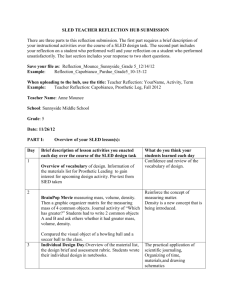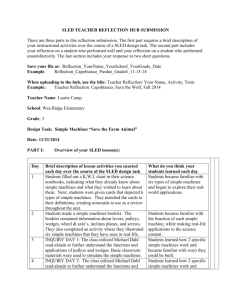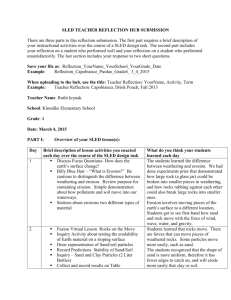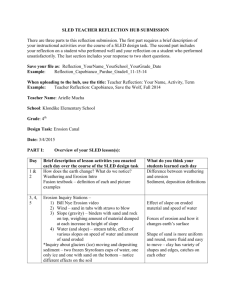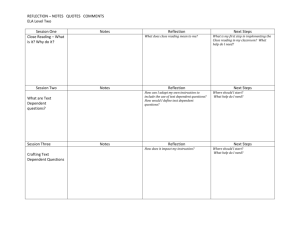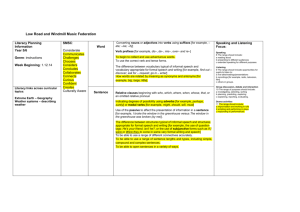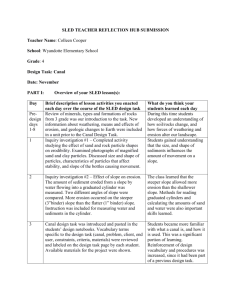gravel discoveries
advertisement
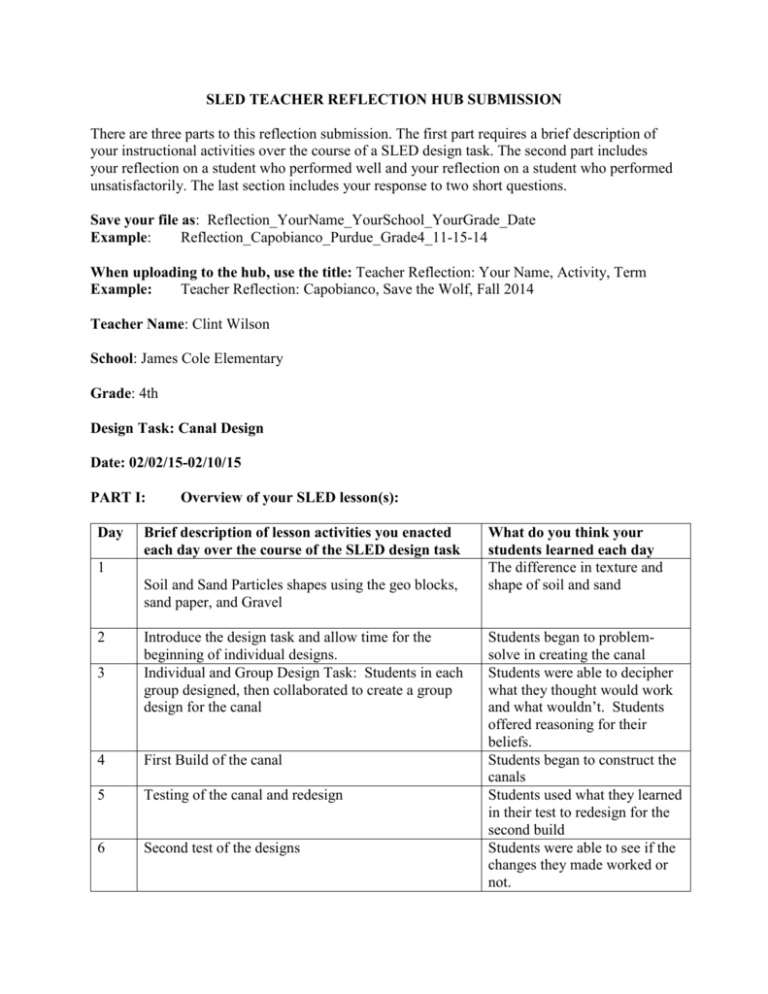
SLED TEACHER REFLECTION HUB SUBMISSION There are three parts to this reflection submission. The first part requires a brief description of your instructional activities over the course of a SLED design task. The second part includes your reflection on a student who performed well and your reflection on a student who performed unsatisfactorily. The last section includes your response to two short questions. Save your file as: Reflection_YourName_YourSchool_YourGrade_Date Example: Reflection_Capobianco_Purdue_Grade4_11-15-14 When uploading to the hub, use the title: Teacher Reflection: Your Name, Activity, Term Example: Teacher Reflection: Capobianco, Save the Wolf, Fall 2014 Teacher Name: Clint Wilson School: James Cole Elementary Grade: 4th Design Task: Canal Design Date: 02/02/15-02/10/15 PART I: Day Overview of your SLED lesson(s): Brief description of lesson activities you enacted each day over the course of the SLED design task 1 Soil and Sand Particles shapes using the geo blocks, sand paper, and Gravel 2 3 Introduce the design task and allow time for the beginning of individual designs. Individual and Group Design Task: Students in each group designed, then collaborated to create a group design for the canal 4 First Build of the canal 5 Testing of the canal and redesign 6 Second test of the designs What do you think your students learned each day The difference in texture and shape of soil and sand Students began to problemsolve in creating the canal Students were able to decipher what they thought would work and what wouldn’t. Students offered reasoning for their beliefs. Students began to construct the canals Students used what they learned in their test to redesign for the second build Students were able to see if the changes they made worked or not. 2 7 Reflecting on the two design tasks Students were able to reflect and learn about the vocabulary involved with erosion and canal building. Please answer the questions below: 1. What worked well? We chose to do things differently for this design task. Students were not front-loaded with information. We didn’t discuss the vocabulary and concepts used in creating a canal prior to the design task. I noticed that after completing the design task, students were able to identify the various vocabulary words and concepts when they reflected on the things that worked well and things that didn’t work well in their designs. After teaching the unit on erosion afterwards, there were many comments such as “Oh, so that’s what the water moving the soil is called.” There were many “discoveries” in each students learning. 2. What are two ways you can improve your efforts toward integrating design? By not front-loading the information, the design process was not very good to begin the task. This was to be expected and is the downfall of not front-loading the information before the design. If I were to teach this lesson again, I would probably introduce vocabulary that is needed before the design task. We allowed students to create and design twice for this lesson. Students appreciated the opportunity to redesign the task after the first attempt. As teachers, Mrs. Ferger and I did not notice great improvements from the first design to the second. It was also demanding in materials which can be costly. If we were to complete a second design, I think we would take more time to discuss improvements with groups or as a whole with the class. 3 PART II: Reflection#1 on student performance: Include an image of work from one student who you thought performed well on the task. Insert the image here within the Word document. This image may be a copy of the student’s notebook entry(s) or an image of the team’s artifact or an actual picture of the student at work. Insert image(s) here In the space below describe what the image(s) is about and why you would explain or characterize the student’s performance as mastery or excellent. This group’s design worked well. The layered screen and Popsicle sticks to keep the sand and dirt in place. While there was still examples of erosion, this group had the least amount of “washout”. The students were also reflective in the second design. Students labeled well and were engaged in the activity. Students kept in mind, the goal of the activity which was to build a canal with the least amount of erosion. Students were able to give an explanation of why the constructed the canal the way they did. They were able to describe each part of the build and it’s purpose. 4 Reflection#2 on student performance: Include an image of work from one student who you thought did not perform as well (unsatisfactory) on the task. Insert the image here within the Word document. This image may be a copy of the student’s notebook entry(s) or an image of the team’s artifact or an actual picture of the student at work. Insert image(s) here In the space below describe what the image is about and why you would explain or characterize the student’s performance as unsatisfactory. 5 These students did not work well together in their group. There was many moments of arguing and the design lacked creativity and skill. This group had the most erosion in their outcome. Students were not able to explain the purpose of the various materials used to complete the task. It was interesting to see how this particular group of students interacted as there didn’t seem to be a group leader that kept everyone on task. 6 PART II: Reflection #3 Describe one thing you enjoyed about instructing this SLED task. This was an enjoyable unit to teach. Chell also assisted us in the project. It was nice to have him here because he filled in some of the “holes” in our instruction. It was also nice having an extra set of hands for passing out materials and testing. It was also nice to see students problemsolving. This is something, in my opinion, students often lack. These tasks force students to think and problem-solve. Describe one thing in your practice you would improve upon next time you implement this engineering design task or another SLED design task. I would have the sand, dirt, and water pre-measured so that it didn’t take as long to test. Often times, students were also off task after testing their design. Those are the two main issues that I would change if we decide to do this design task again.

